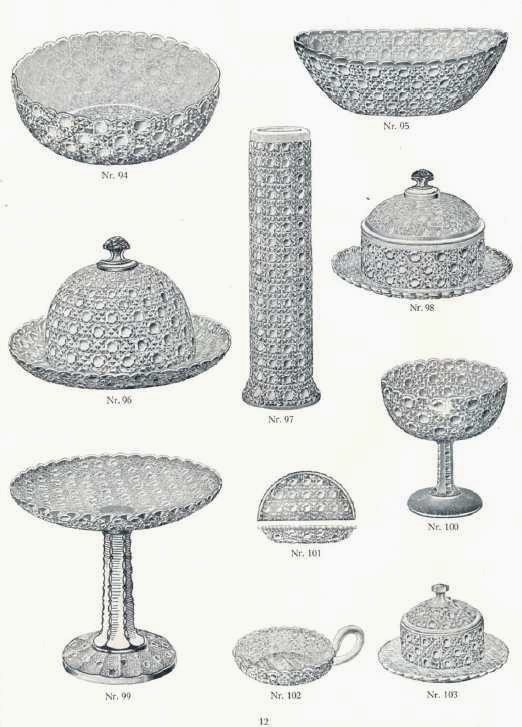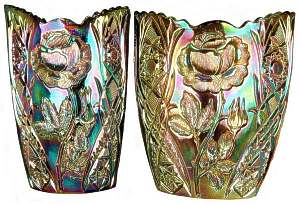Kutzscher - Some Questions
Some Questions to Ponder.
We have already looked in detail at whether or not Brockwitz used Kutzscher to provide some of their moulds, and currently we cannot find any firm evidence to suggest that this was the case. We feel that it was most likely (but not one hundred percent certain) that Brockwitz made and used most of their own moulds, and some moulds from other glassworks that they acquired: Radeberg, Plotz and Ottendorf Okrila in 1914, and Sornewitz in 1923.
Let’s examine a couple of patterns where the waters are a little muddy: Regal Cane and Elektra.
We have already looked in detail at whether or not Brockwitz used Kutzscher to provide some of their moulds, and currently we cannot find any firm evidence to suggest that this was the case. We feel that it was most likely (but not one hundred percent certain) that Brockwitz made and used most of their own moulds, and some moulds from other glassworks that they acquired: Radeberg, Plotz and Ottendorf Okrila in 1914, and Sornewitz in 1923.
Let’s examine a couple of patterns where the waters are a little muddy: Regal Cane and Elektra.
|
Regal Cane The cane design is an old one, seen in cut glass patterns in Europe and later, the USA, dating back to the 1800s, and many glassworks produced versions of the cane design in pressed glass, inspired by the earlier “cut” designs. In England, Sowerby and Davidson (see right) each made a version in the 1890s, Portieux in France produced their version in 1894, St. Louis in 1901, Portugal’s Marinha Grande also made a version in 1901 and the French firm Baccarat did theirs in 1907. The Regal Cane pattern (original Brockwitz name Hammonia) is featured in the known Brockwitz 1915 catalogue and shown below. It is the earliest Brockwitz catalogue that has been discovered so far, but note that Brockwitz had been successfully making glass for 12 years before that catalogue was issued, thus the pattern could have been introduced a decade or more earlier. |
However, a very similar pattern was shown in the 1910 Sornewitz catalogue (below, left) where it was called Diamant (interestingly, the Sornewitz Diamant pattern range was unashamedly promoted as an imitation of Baccarat’s similar design!) The shapes were very different to the Brockwitz ones in the similar pattern, and only one or two specific shapes were directly comparable, such as the tall cylinder vase. Interestingly, Kutzscher’s design catalogue of 1910, below right, also features several shapes in a very similar pattern.
It is easy to be led astray by the dates of these catalogues – it is more important to look at the bigger picture. An assumption could be made that Kutzscher made the moulds in this pattern for Sornewitz and then Brockwitz, as the catalogues appear to be in succession. But the catch here is that we simply do not have any earlier catalogue from Brockwitz to study. They have not yet been discovered! However, Brockwitz was producing glass from 1903, and could easily have introduced their Hammonia / Regal Cane pattern before 1910, and indeed it might have simply been copied by Kutzscher.
It is easy to be led astray by the dates of these catalogues – it is more important to look at the bigger picture. An assumption could be made that Kutzscher made the moulds in this pattern for Sornewitz and then Brockwitz, as the catalogues appear to be in succession. But the catch here is that we simply do not have any earlier catalogue from Brockwitz to study. They have not yet been discovered! However, Brockwitz was producing glass from 1903, and could easily have introduced their Hammonia / Regal Cane pattern before 1910, and indeed it might have simply been copied by Kutzscher.
Davidson Hobnail Suite catalogue extract is courtesy of the Corning Glass Museum. The Brockwitz 1915 catalogue is courtesy of Dieter Neumann.
The Kutzscher design catalogue and the Sornewitz catalogue are both courtesy of Seigmar Gieselberger.
The Kutzscher design catalogue and the Sornewitz catalogue are both courtesy of Seigmar Gieselberger.
Elektra
The time line here is not clear cut and to confuse matters more, this design was also illustrated in the Kutzscher catalogue. Let’s follow the facts and see where the evidence leads us.
As shown below, Kutzscher design catalogues show the pattern we know as Elektra in their 1924 catalogue in a breakfast set (sugar, creamer and tray). Brockwitz named the pattern Elektra and show a range of shapes in their 1926 catalogue.
The time line here is not clear cut and to confuse matters more, this design was also illustrated in the Kutzscher catalogue. Let’s follow the facts and see where the evidence leads us.
As shown below, Kutzscher design catalogues show the pattern we know as Elektra in their 1924 catalogue in a breakfast set (sugar, creamer and tray). Brockwitz named the pattern Elektra and show a range of shapes in their 1926 catalogue.
The Elektra pattern shown in the 1924 Kutzscher design is prior to the pattern appearing in the 1926 Brockwitz catalogue, which taken at face value might suggest that Kutzscher made the moulds of the Elektra design for Brockwitz (or Brockwitz copied it from Kutzscher). However, it is not possible to know which came first. It is also important to know that currently there are no known Brockwitz catalogues from the years 1922 to 1925, meaning it is entirely possible that Brockwitz could have introduced Elektra from as early as 1922, and then Kutzscher simply copied Brockwitz. Based on current evidence we feel it is not possible to prove the case either way.
The above extracts show the significant differences between the Kutzscher and Brockwitz designs. The Brockwitz versions have rounded handles on both sugar and creamer, while the Kutzscher version only has a handle on the creamer, and it’s a squared Chippendale style. The edge of the tray is also very different.
It seems inconceivable that Brockwitz – who stated that they “made all their own moulds” in their vast mould shop, and at a time when they were actively registering patents for improved mould design – would go to another mould maker. It’s much more likely that Brockwitz's patterns “inspired” Kutzscher to offer a drawing with a similar look, in the hopes that yet another glass maker would buy it. And indeed, it looks as if another glass maker did just that! The Riihimaki/Kauklahti catalogue of 1927-8 featured five different shapes of sugar (four are double handled and one is pedestal footed) and three different shapes of creamer, all in the Elektra pattern! The pattern also features a decade later, again in Riihimaki’s 1939 catalogue (below), the sugar and creamer (in two different shapes of both sugar and creamer).
The above extracts show the significant differences between the Kutzscher and Brockwitz designs. The Brockwitz versions have rounded handles on both sugar and creamer, while the Kutzscher version only has a handle on the creamer, and it’s a squared Chippendale style. The edge of the tray is also very different.
It seems inconceivable that Brockwitz – who stated that they “made all their own moulds” in their vast mould shop, and at a time when they were actively registering patents for improved mould design – would go to another mould maker. It’s much more likely that Brockwitz's patterns “inspired” Kutzscher to offer a drawing with a similar look, in the hopes that yet another glass maker would buy it. And indeed, it looks as if another glass maker did just that! The Riihimaki/Kauklahti catalogue of 1927-8 featured five different shapes of sugar (four are double handled and one is pedestal footed) and three different shapes of creamer, all in the Elektra pattern! The pattern also features a decade later, again in Riihimaki’s 1939 catalogue (below), the sugar and creamer (in two different shapes of both sugar and creamer).
Did Factories in South America use Kutzscher Moulds?
We have researched and frequently written in many publications about the links between Europe, the USA and the Carnival Glass producing countries of South America - all our information on this can be accessed from our Carnival Glass from South America page.
We have researched and frequently written in many publications about the links between Europe, the USA and the Carnival Glass producing countries of South America - all our information on this can be accessed from our Carnival Glass from South America page.
|
In our recent feature (© April, 2016) on Butters From Brazil, we noted that various Carnival patterns might have been inspired by some Kutzscher designs, for example, Renaissance and Teardrop. It’s possible that moulds may have been made by Kutzscher for South American use, but it’s probably more likely that similar-looking designs were simply copied. Further research and hard evidence such as order forms or receipts, would be the clincher. One in particular, called “Sunball”, had caught our eye. Our April 2016 feature was the first to show the link between this beautiful covered comport (photo courtesy Álvaro Aguiar and Cláudio Deveikis) and a Kutzscher drawing. We wrote that “the exact pattern is not known to us in any European glass maker’s catalogue, but here it is, found in Brazil. Possibly the mould was made by Kutzscher and purchased by a Brazilian glass company, such as Esberard. Whatever its story, the result is a strikingly beautiful piece of Carnival Glass.” Interestingly, the “Sunball” design (with one small change) is also the “Edstrom” pattern made by Eda Glasbruk and shown in The Kutzscher Design Gallery. |
Left: Kutzscher catalogue, 1924. Courtesy Siegmar Geiselberger
Right: Sunball covered comport, found in Brazil. Courtesy Cláudio Deveikis and Álvaro Henrique Nicolau Aguiar. |
The Sunk Daisy Mystery
Kutzscher were almost certainly involved in the complex story of the production of this design. The tale appears to begin in southern Europe around 1900, crosses the Atlantic, then goes to Scandinavia (probably with a little help from Kutzscher in Germany).
The full story of this fascinating design will be published on a new Collectors Facts page that we are working on currently.
Kutzscher were almost certainly involved in the complex story of the production of this design. The tale appears to begin in southern Europe around 1900, crosses the Atlantic, then goes to Scandinavia (probably with a little help from Kutzscher in Germany).
The full story of this fascinating design will be published on a new Collectors Facts page that we are working on currently.
This is the final section of our four page feature on Kutzscher - we hope you enjoyed it!
Return to:
The Kutzscher Story
Kutzscher and Brockwitz: Original or Inspired designs?
Kutzscher Designs: The designs that were born in glass.
Click on any image













